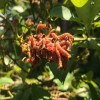What to Watch For: Caterpillars in Berries
go.ncsu.edu/readext?419329
en Español / em Português
El inglés es el idioma de control de esta página. En la medida en que haya algún conflicto entre la traducción al inglés y la traducción, el inglés prevalece.
Al hacer clic en el enlace de traducción se activa un servicio de traducción gratuito para convertir la página al español. Al igual que con cualquier traducción por Internet, la conversión no es sensible al contexto y puede que no traduzca el texto en su significado original. NC State Extension no garantiza la exactitud del texto traducido. Por favor, tenga en cuenta que algunas aplicaciones y/o servicios pueden no funcionar como se espera cuando se traducen.
Português
Inglês é o idioma de controle desta página. Na medida que haja algum conflito entre o texto original em Inglês e a tradução, o Inglês prevalece.
Ao clicar no link de tradução, um serviço gratuito de tradução será ativado para converter a página para o Português. Como em qualquer tradução pela internet, a conversão não é sensivel ao contexto e pode não ocorrer a tradução para o significado orginal. O serviço de Extensão da Carolina do Norte (NC State Extension) não garante a exatidão do texto traduzido. Por favor, observe que algumas funções ou serviços podem não funcionar como esperado após a tradução.
English
English is the controlling language of this page. To the extent there is any conflict between the English text and the translation, English controls.
Clicking on the translation link activates a free translation service to convert the page to Spanish. As with any Internet translation, the conversion is not context-sensitive and may not translate the text to its original meaning. NC State Extension does not guarantee the accuracy of the translated text. Please note that some applications and/or services may not function as expected when translated.
Collapse ▲The season’s first question about caterpillars in blueberries has arrived, so growers and homeowners should be on the look out for developing populations. Several caterpillars species in the genus Datana feed on NC blueberries. These are generally called yellow necked caterpillars. I generally get several questions about them each year and have posted about them in the past on my former blog.

Datana spp. caterpillars feeding on blueberry. Photo via NC State University Plant Disease and Insect Clinic.
In addition to yellow necked caterpillars, red humped caterpillars (Schizura concinna) may also feed on blueberries and blackberries and cause similar damage.
In general, post harvest leaf feeding caterpillars in blueberries or blackberries are relatively easy to control. They are often localized to a few bushes, and if caught early can be pruned out or hand removed. In the uncommon cases where yellow necked or red humped caterpillars are wide spread enough to justify insecticide treatment, they can be controlled with a range of conventional and organically acceptable insecticides. See the NC Agricultural Chemical Manual for more detailed management information.


